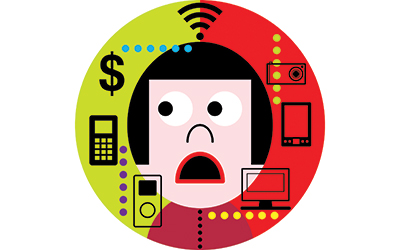Expert Source: Ryan T. Howell, PhD, assistant professor of psychology, cofounder of BeyondthePurchase.org, and director of the Personality and Well-being Lab at San Francisco State University.
For many of us, digital devices and social-media streams have morphed from nifty diversions into absolute necessities. They render us reachable, teachable and employable. They keep us connected with our friends and family. They define us as either plugged in and geeky-cool — or “so 2004.”
Accordingly, they can also be a colossal source of stress. We may feel clueless and anxiety-ridden as we contemplate which devices will make a substantial difference in our lives (enough to justify the price) and which might be overhyped. We can feel overwhelmed by the pace at which new mobile apps and social-media streams are merging onto our already-clogged information superhighway (TikTok! Pinterest! Instagram! SnapChat!). Seeing digital tools as status symbols adds yet another layer to our technological hand wringing.
Here, Ryan T. Howell, PhD, offers advice on overcoming the stress of keeping up with ever-evolving technology.
Barriers to Overcome
- Fear of being uncool or left behind. Will you be seen as a dinosaur by your early-adopter friends if your laptop is a couple of years old or you don’t have a smartphone? Could you miss out on real-world social or career opportunities if you’re not on Facebook, LinkedIn or Twitter? There’s some reality here, notes Howell: Many meet-ups, especially spontaneous ones, happen via text or social-media apps. Similarly, job opportunities often originate on social-media or professional-networking sites.
- “Latest and greatest” anxiety. Digital-product manufacturers are good at making us feel that the newest device, feature or platform isn’t just convenient or quick, it’s so full of up-to-the-minute excitement that it will validate our very existence. Marketers want us to feel that we’ll miss out on the best in life if we don’t buy this or that gadget — and its next version, too.
- Social-status signaling. “If you’re struggling financially or dissatisfied with your income,” says Howell, “you may feel a strong urge to purchase high-status items.” People often try to quiet financial anxieties — and disguise the reality of their situation — by purchasing items that signal wealth and abundance. But this habit compounds money problems, leading to more anxiety and more buying.
- Fear of being underequipped. Howell emphasizes that there are real and cogent reasons to keep up with tech when your work demands it. If your digital skill set isn’t up to speed, you may become less valuable as an employee or a job seeker. If you’re a freelancer, you may need to meet the tech-level expectations of your clients to continue getting work. But this fear is often exaggerated beyond its likely implications — particularly because there’s rarely a clear answer to “How current is current enough?”
- Keeping track. The speed at which tech evolves, combined with the unfettered proliferation of products, platforms, programs and services, can make keeping your finger on the pulse of digital progress virtually impossible.
Strategies for Success
- Assess your professional tech needs. “It’s important to find out what you really need for work and professional credibility,” says Howell. The best way to discern this is to periodically touch base with your colleagues, manager and even the IT department at work about expectations, upgrades and essential software. This ensures that you are keeping pace with those around you, and you will likely discover new tech that can make your job easier and improve performance.
- Take stock of your current stuff. Make an inventory of the tech you own right now and divide the list into two categories: devices, programs and software that you use regularly and ones that you don’t. With everyday-use items, ask yourself what you like about them and why they fit into your life so seamlessly. With rarely or never-used items, ask yourself what makes them less useful and convenient for you. Use your answers to guide future purchases and app downloads. (Explore this three-step plan to streamline your digital life and reclaim time for what matters most to you.)
- Clarify your personal tech goals. Do you want to be more active on social media, or do you feel trapped by the constant interaction? Do you aspire to make great videos, or do you just want to get your photos into albums? Are you desperate to get your calendar syncing properly to your smartphone, or do you simply want to get your phone’s Bluetooth connection working in the car? Focusing on what you really want and need will help you make smarter, more practical decisions about how you spend your time and money on technology.
- Assess upgrades with healthy skepticism. “Marketers are great at taking small differences or small changes and making them seem really big,” says Howell. Do some sleuthing before you purchase: Are the changes in Widget 2.3 really major enough to make it necessary for you to let go of 2.2? Will the upgrades meaningfully improve how the apps and software function for you?
- Find a tech mentor. A trusted, tech-savvy friend can advise you frankly on the advantages and disadvantages of new devices, helping you to sort out the difference between needs and desires, to choose wisely, and to search for bargains. If you don’t already know such a person, put the word out among your friends that you’re looking. Resources like CNET (a Consumer Reports–like website at www.cnet.com that specializes in tech) can help, too.
- Stay focused on what matters. “If all of your friends have the newest phone and you have last year’s model, you might think that you’ll be shunned or looked down on, but that rarely happens,” says Howell. First, he notes, people don’t think about us nearly as often as we think they do. They are too busy dealing with their own challenges. Second, the things you buy just don’t have that much of an impact on people’s desire to be friends with you, says Howell; far more important is your authentic interest in and commitment to them.
- Name that emotion. When you feel the urge to buy a new tech item that isn’t related to practical needs in your work or home life, you’ll probably have either a sense of ambivalence about it or a disproportionate rush of excitement. These could be indicators that your urge to purchase is being driven by underground emotions. Take a moment to notice where your desire is really coming from, advises Howell. “Can you name the deeper emotion that might be driving your urge to upgrade? A sense of deprivation, sadness, envy, worry, boredom, status anxiety?” When you identify the emotions behind the craving, you’re better able to think rationally about the purchase and whether or not it makes sense for your life.
- Remember that satisfaction is not guaranteed. “In social psychology there’s the concept of ‘affective forecasting’ — our ability to predict how happy a new product is going to make us,” says Howell. “Studies show we’re pretty bad at it. The expectation that we’re going to have transformative experiences if we get certain products is rarely fulfilled. You’re probably going to significantly overestimate the degree to which changes in technology will add excitement to your life.”
This article originally appeared as “Keeping Up With the Jetsons.”





This Post Has 0 Comments